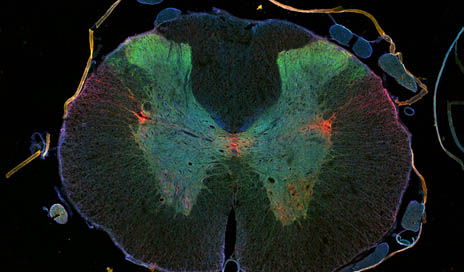
Cross section rat spinal cord. Immunostaining: axons (red), synapses (green), motor neurons (blue). Source: DZNE/Jörg Ruschel
The search for a healing agent for spinal cord injuries got an unexpected helping hand recently from a cancer drug. Researchers reported in the journal Science that epothilone, known among cancer treatment circles as a cytotoxin, reduces the formation of scar tissue and stimulates damaged nerve cells to grow in an animal model.
A team of researchers based at the DZNE – German Center for Neurodegenerative Diseases, and led by Professor Frank Bradke, demonstrated that epothilone decreases scar tissue growth by inhibiting the formation of microtubules in the cells that form scar tissue. This keeps the microtubules from moving to the spinal cord lesion where they can cause wound scarring. The researchers note that while this is happening epothilone promotes growth and regeneration in the nerve cells by causing microtubules to grow into the damaged axon tips.
According to a report posted to the DZNE website, the microtubule stabilization allows epothilone to inhibit directional movement in scar-forming cells while stimulating active growth in nerve cell axons.
“The ideal treatment for promoting axon regeneration after spinal cord injury would inhibit the formation of scar tissue,” Bradke states in the website report.
The report also reveals the animals treated with epothilone after spinal cord injury walked better than those that received no treatment, due to improved balance and coordination
Epothilone is available to the U.S. market, where it is licensed for use in cancer treatment.
“It all depends on the dose,” Dr. Jörg Ruschel, the study’s lead author, notes. “In higher doses, epothilone inhibits the growth of cancer cells, while low doses have been shown to stimulate axonal growth in animals without the severe side-effects of cancer treatment.” Epothilone is said to be superior to other cancer drugs with a similar effect because it reportedly can penetrate the blood-brain barrier into the central nervous system, and reach the damaged axons directly.
[Source: ScienceDaily, DZNE]





